Sunswift 7: Driving technology forward
UNSW's latest high-performance solar-powered car, designed and built by students, is now on track for
an incredible Guinness World Record attempt.

When Sunswift 7 lines up to potentially break a new world speed record in December, it won’t just be the culmination of thousands of hours of work by a team of UNSW students over a period of 18 months through the perils of Covid and its associated lockdowns.
Instead, it will be the product of more than 25 years of heritage when it comes to producing high-performance solar-powered racing cars.
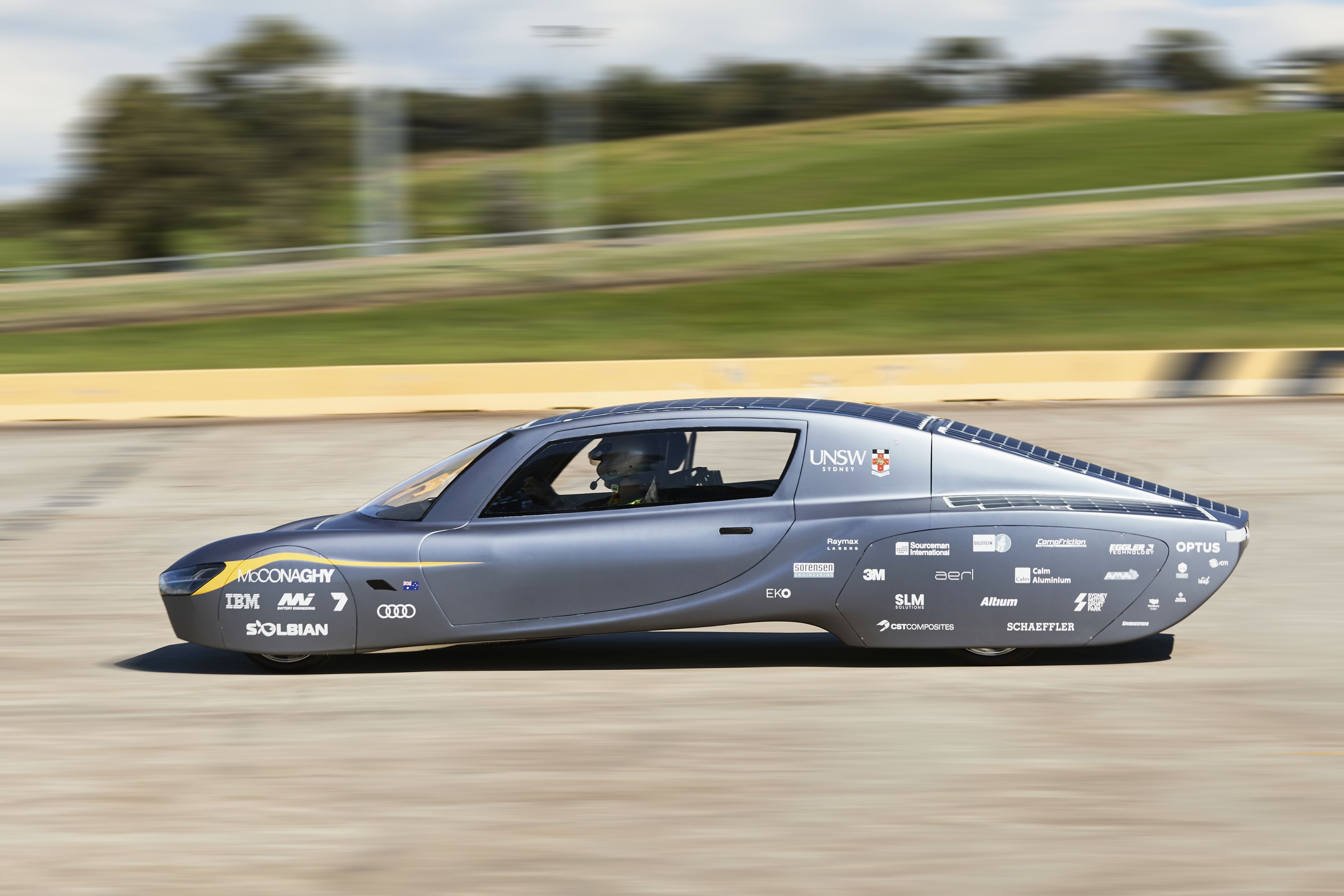
Sunswift 7 in testing at Sydney Motorsport Park. Photo: UNSW Sydney / Richard Freeman
Sunswift 7 in testing at Sydney Motorsport Park. Photo: UNSW Sydney / Richard Freeman
Sunswift Racing, which officially unveiled its latest car this week, has been pushing the boundaries of solar vehicle technology since 1996 and enjoyed success in numerous races, most notably the World Solar Challenge, and collected motorsport records along the way.
The seventh car to be produced will aim to set the Guinness World Record for the fastest solar electric car over 1000km at the Australian Automotive Research Centre in Victoria, with the team hoping they can achieve an average speed of over 120km/h for the entire distance.
That will be just one reward for many months of hard work designing and building the car, which would have been difficult enough without the additional challenges of the pandemic.
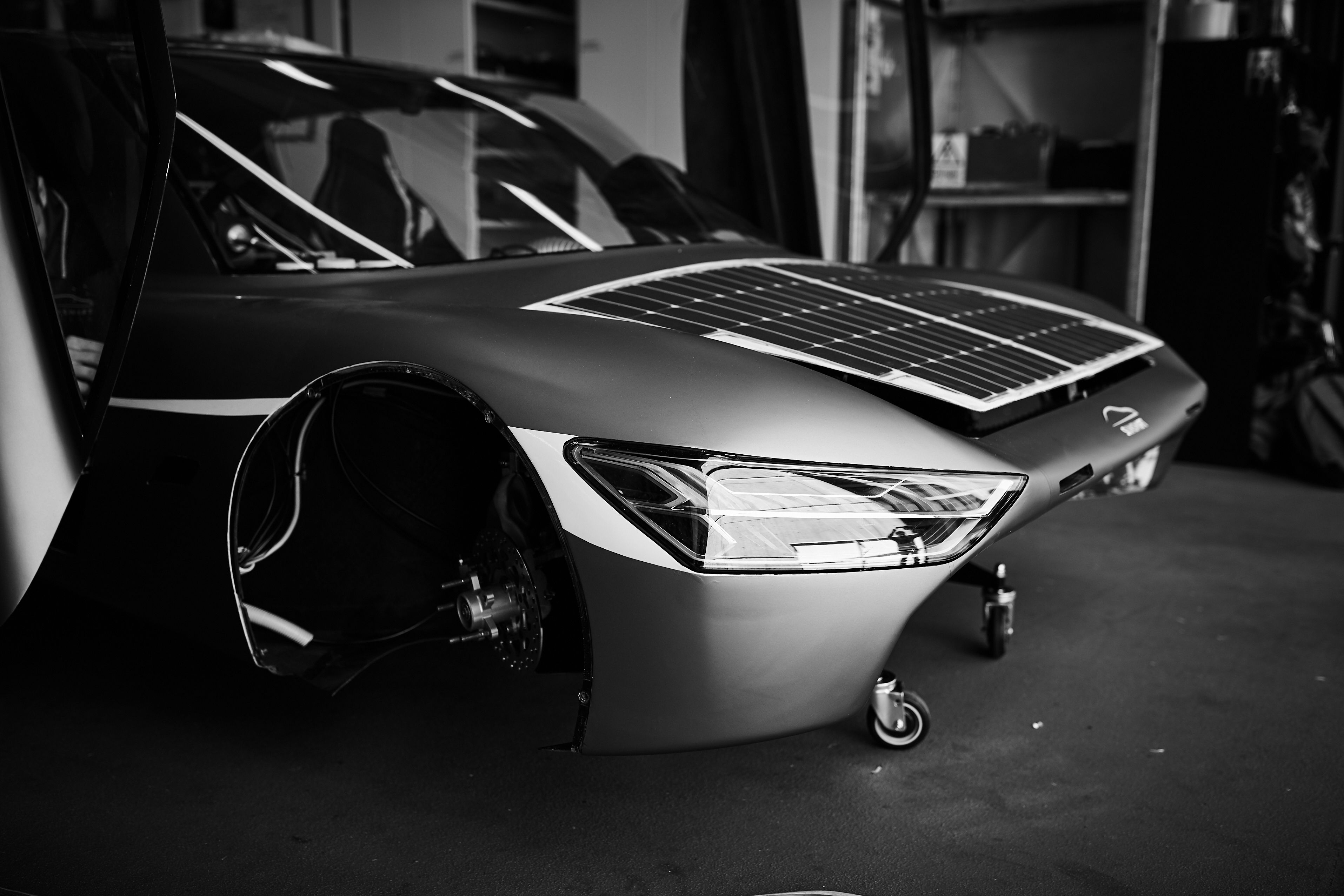
Which is why Sunswift team principal, Professor of Practice Richard Hopkins, is immensely proud of everything the students have achieved just to get the car out onto the track.
“This is the result of the hard work of 50 undergraduate students who are very dedicated, very focused and very talented,” he said.
“They were given the freedom to create. The criteria was simply: build a car that has solar power and a battery. I had very little influence over what they chose to do within that – I just wanted them to make the best engineering decisions.
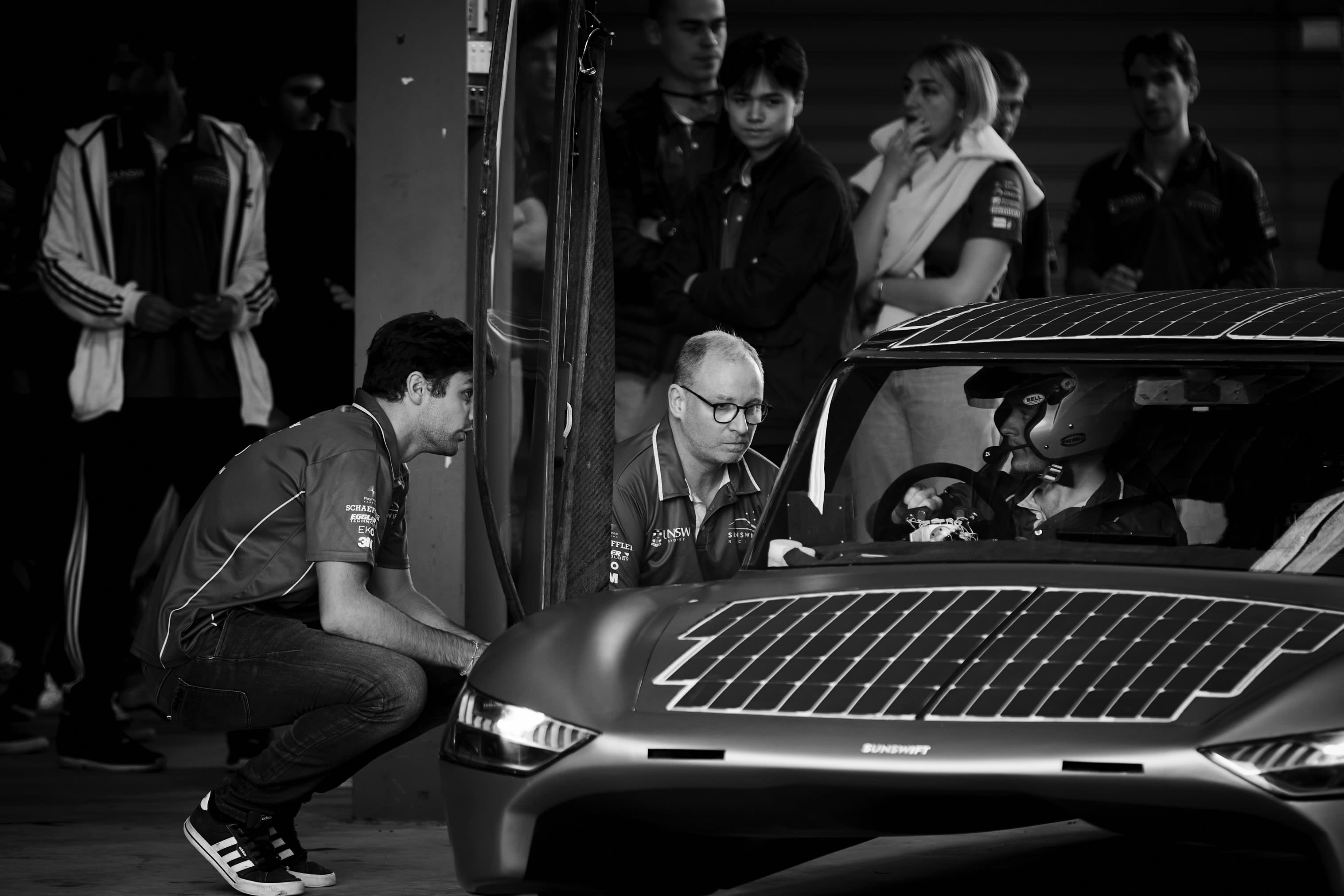
UNSW Professor of Practice Richard Hopkins talks with the Sunswift team during testing of the car at Sydney Motorsport Park. Photo: UNSW Sydney / Richard Freeman
UNSW Professor of Practice Richard Hopkins talks with the Sunswift team during testing of the car at Sydney Motorsport Park. Photo: UNSW Sydney / Richard Freeman
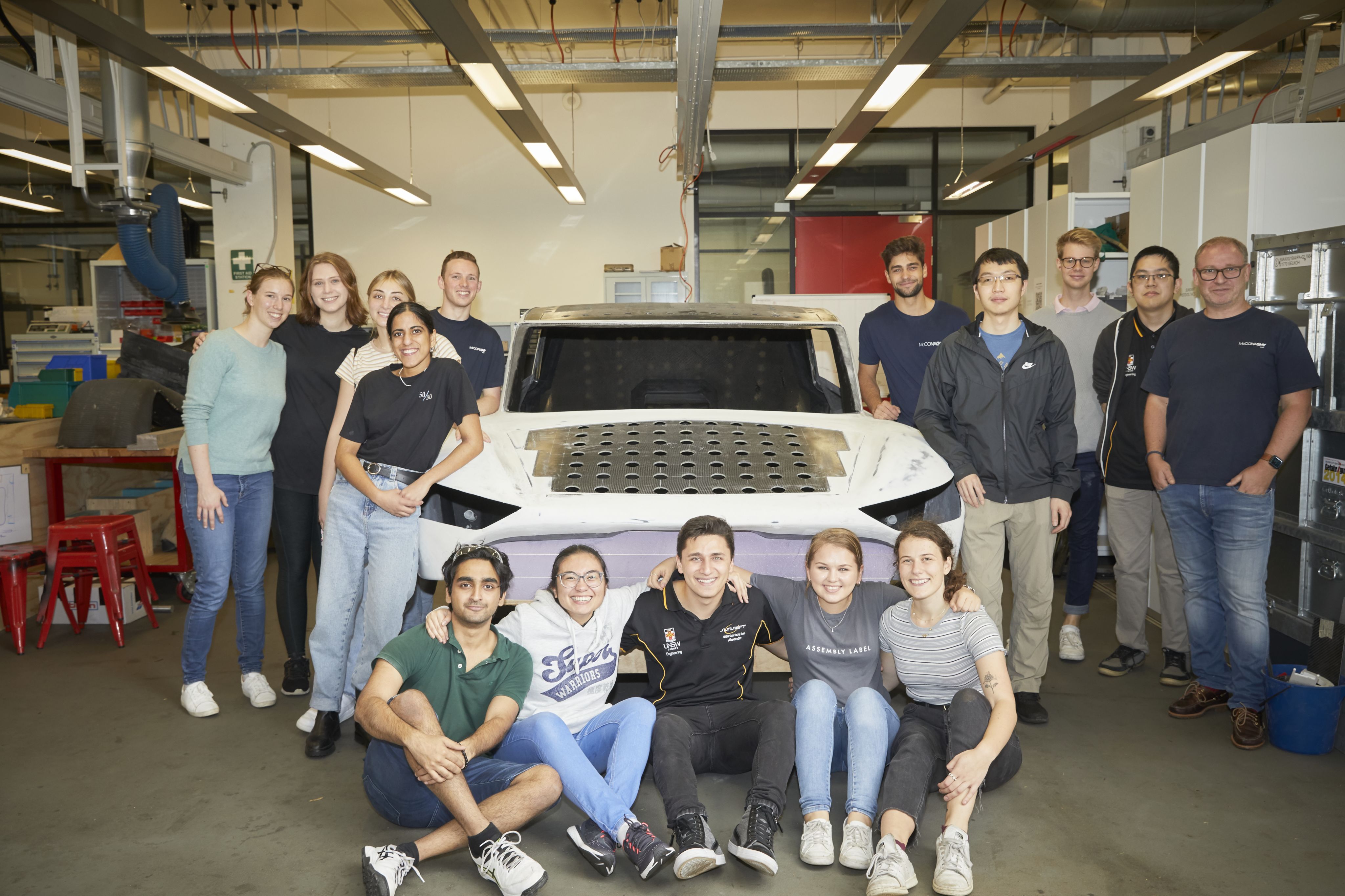
Members of the UNSW Sydney student team who designed, built and developed the Sunswift 7 solar car. Photo: UNSW Sydney / Richard Freeman
Members of the UNSW Sydney student team who designed, built and developed the Sunswift 7 solar car. Photo: UNSW Sydney / Richard Freeman
“Sunswift 7 is the manifestation of their collective minds, who on day one probably had very little idea what they were doing. And now to produce this amazing car is just insane.
“Let’s remember, these are not the best paid professional car makers in Stuttgart working for Mercedes. This is a bunch of very smart amateurs who have taken all the ingredients and put it together in a brilliant way."
Sunswift 7 should have been racing since the start of 2021, with events such as the prestigious World Solar Challenge on the schedule.
All that had to be shelved when Covid lockdowns severely delayed the build, and then also wiped out the majority of high-profile events as international teams were simply unable to travel.
But Prof. Hopkins, formerly Head of Operations for the Red Bull Racing Formula One team, was able to draw on his experience in the top levels of motorsport to guide the team through the challenges.
“That whole period of going in and out of Covid lockdowns reminded me very much of when I was in Formula One.
"In that high-pressure environment, when you are losing you can feel as if you are at rock bottom, but you know you have to retain your focus and work exactly the same as if you were winning," he says.
“You draw on a resilience you never knew you had. I think in that situation, it was just important for the Sunswift team to continue to communicate.
"If we weren't in a lockdown, we had to absolutely maximise the time we had because you never knew when something else was going to happen.”
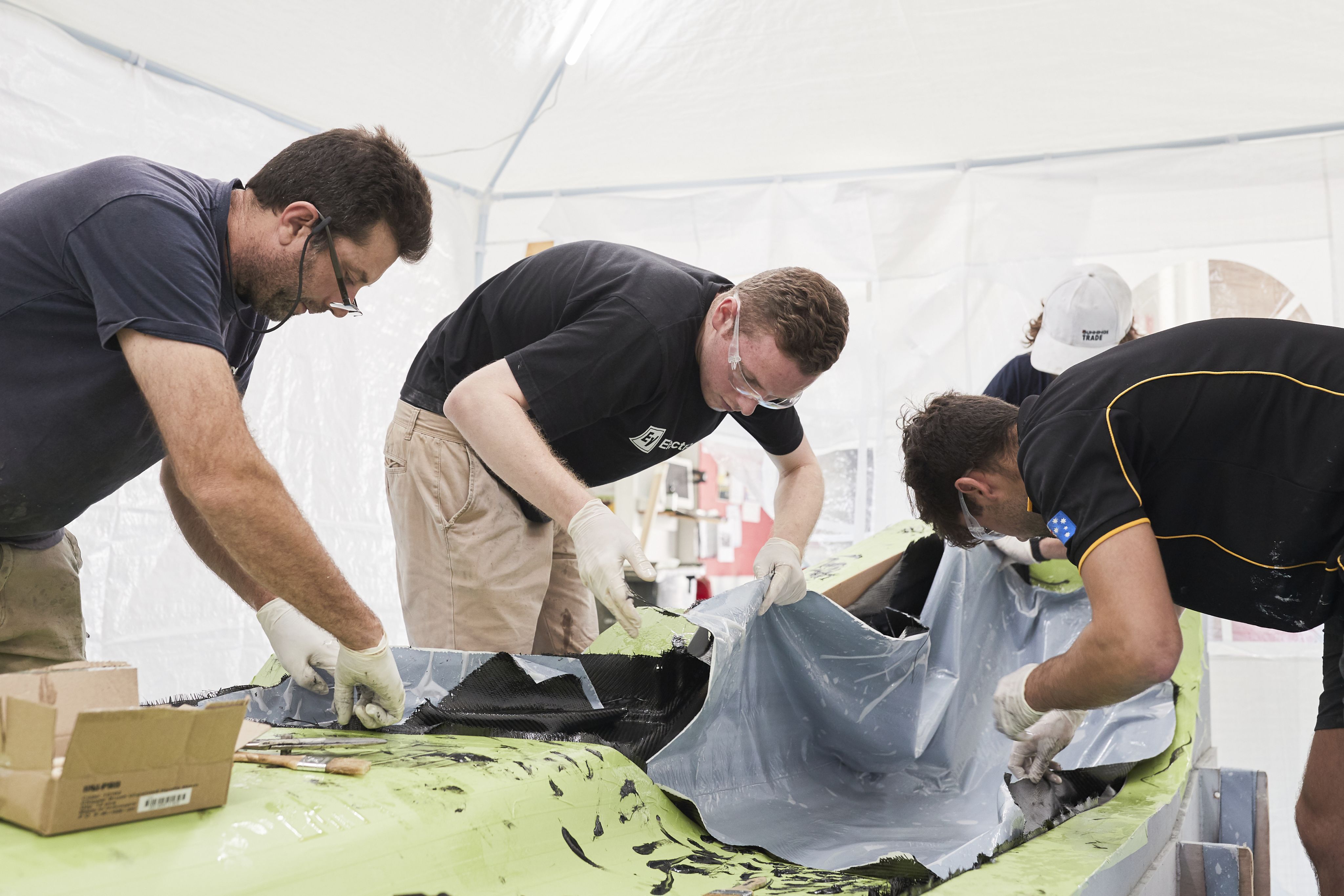
Sunswift team work on the chassis of the car at the McConaghy boats facility in Gosford, NSW. Photo: UNSW Sydney / Richard Freeman
Sunswift team work on the chassis of the car at the McConaghy boats facility in Gosford, NSW. Photo: UNSW Sydney / Richard Freeman
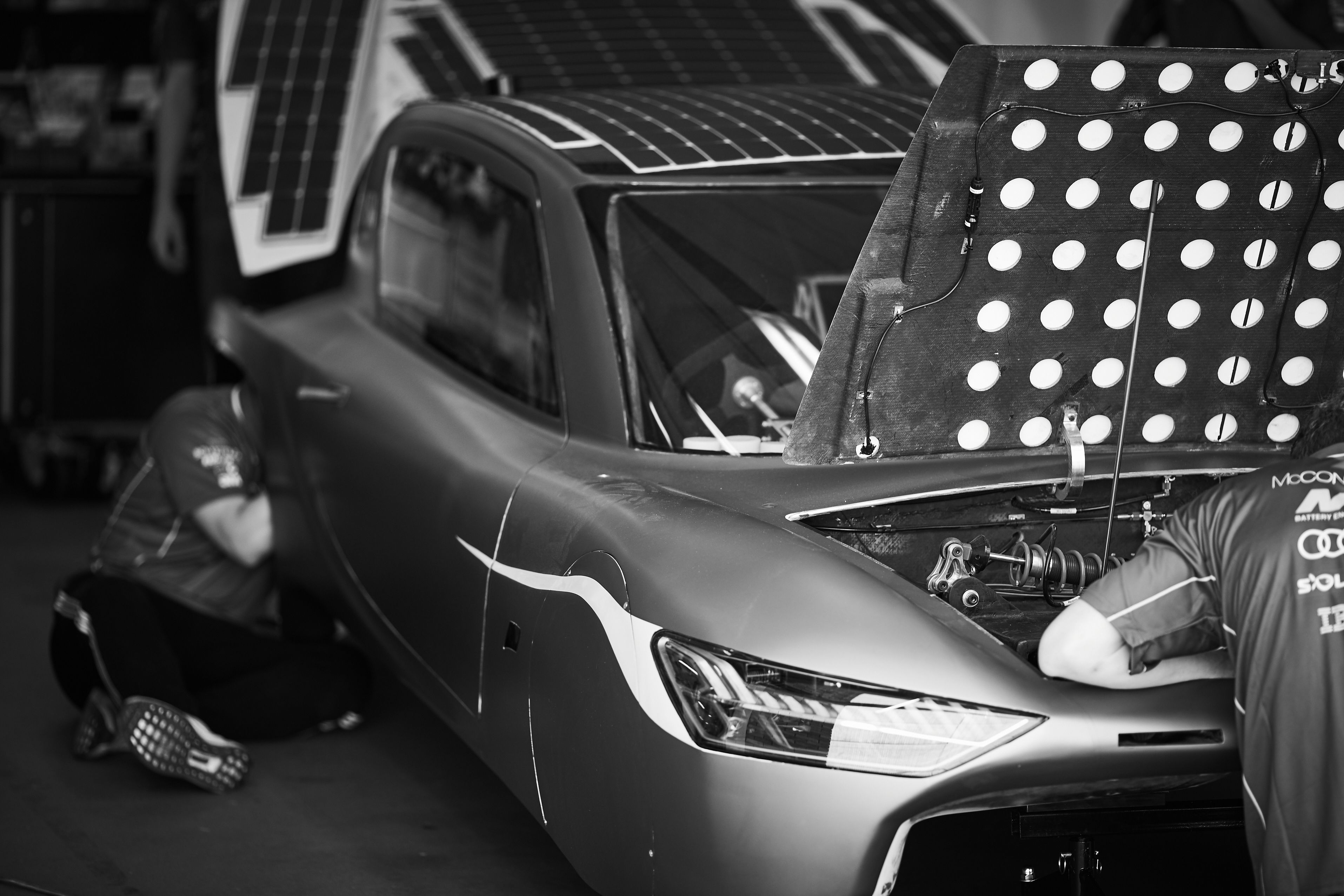
Sunswift 7 has a carbon fibre frame to reduce its overall weight and improve efficiency. Photo: UNSW Sydney / Richard Freeman
Sunswift 7 has a carbon fibre frame to reduce its overall weight and improve efficiency. Photo: UNSW Sydney / Richard Freeman
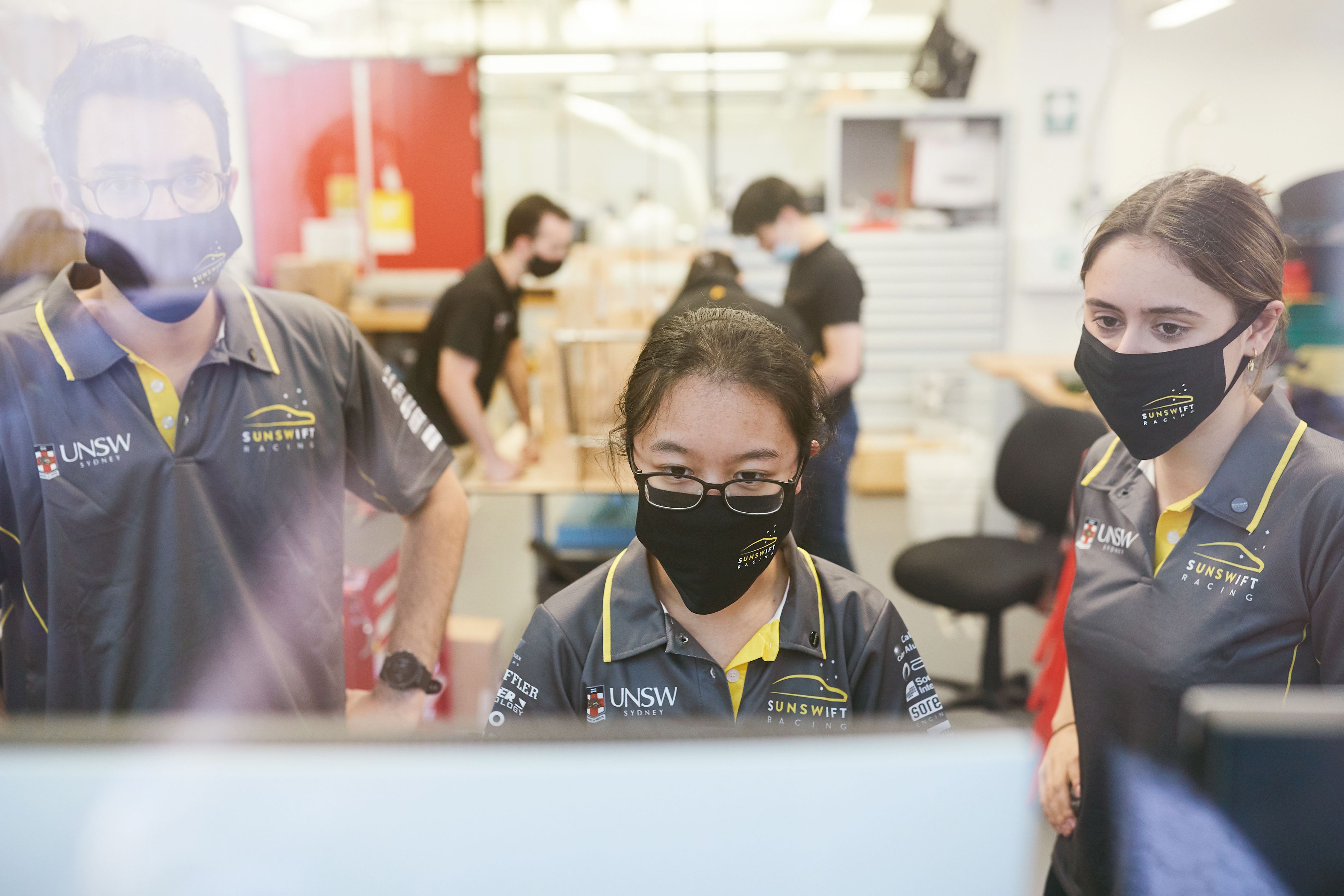
Sunswift Racing is made up of around 50 undergraduate students from UNSW Sydney. Photo: UNSW Sydney / Richard Freeman
Sunswift Racing is made up of around 50 undergraduate students from UNSW Sydney. Photo: UNSW Sydney / Richard Freeman
Sunswift's student
success stories
For team manager, Mechanical Engineering student Andrea Holden, working on the Sunswift project from start to finish has been a massive thrill – albeit extremely demanding.
And she believes it is something every student should aspire to be involved with.
"I remember in the interview to join the Sunswift team, they said it would be the most challenging thing I could do. At the time I thought that was a bit dramatic, but it is absolutely correct,” Ms Holden says.
"But as much as it is challenging, and also stressful, the benefits and the learnings from it outweigh that by 100 per cent.
"Meeting deadlines for university coursework is one thing – if you don't meet that deadline then the only person affected is yourself.
"But with a project like Sunswift, if you don't meet a deadline then it has a knock-on effect for many other people.
"I think that level of responsibility is a really good thing, though, and not many people experience it at university level.
"Some students might do internships and get real-world experience on projects for three months here, or three months there.
"But we have been involved from the design phase, through to the build, then testing and hopefully achieving our goals.
"And I think that it's an absolutely invaluable experience."
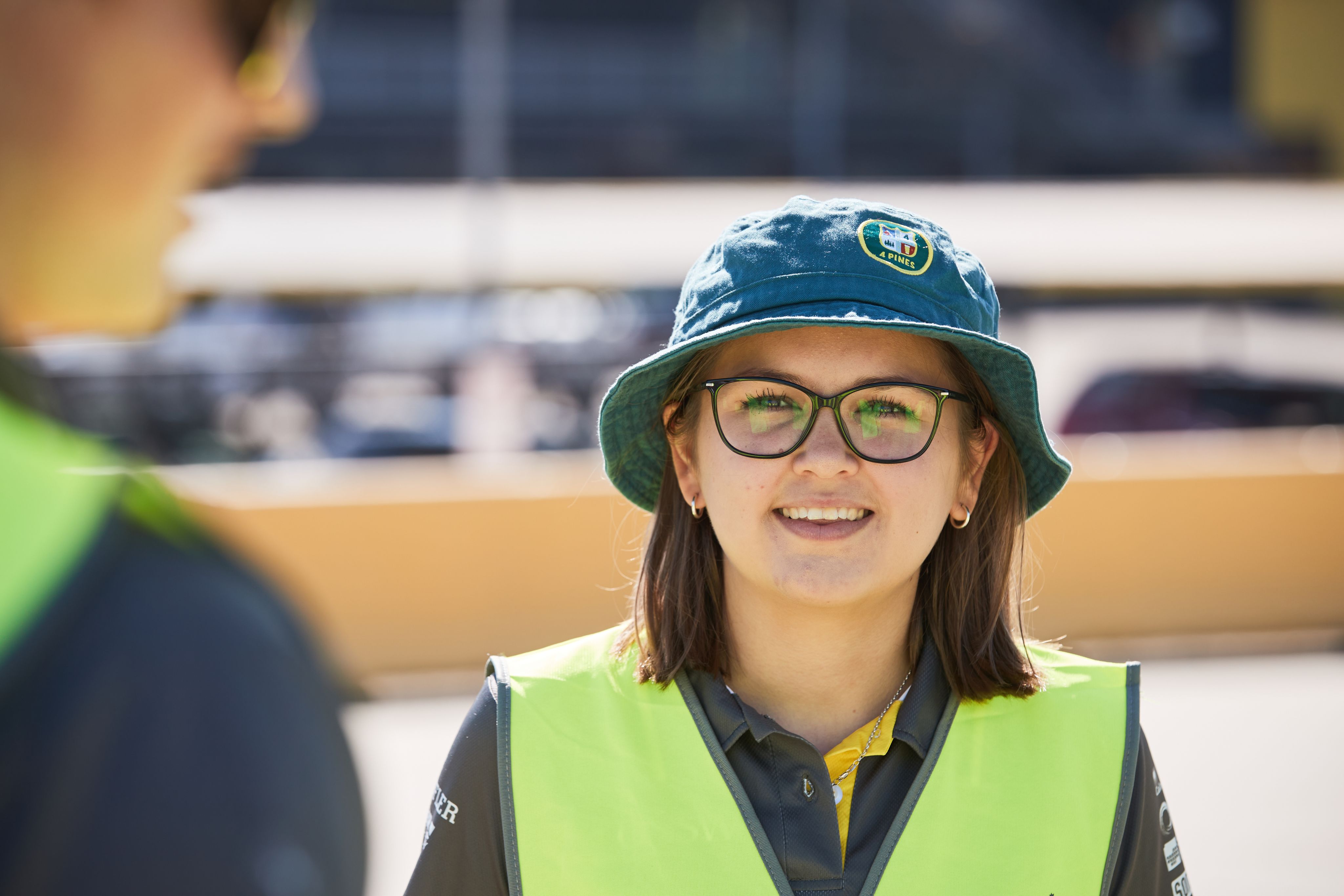
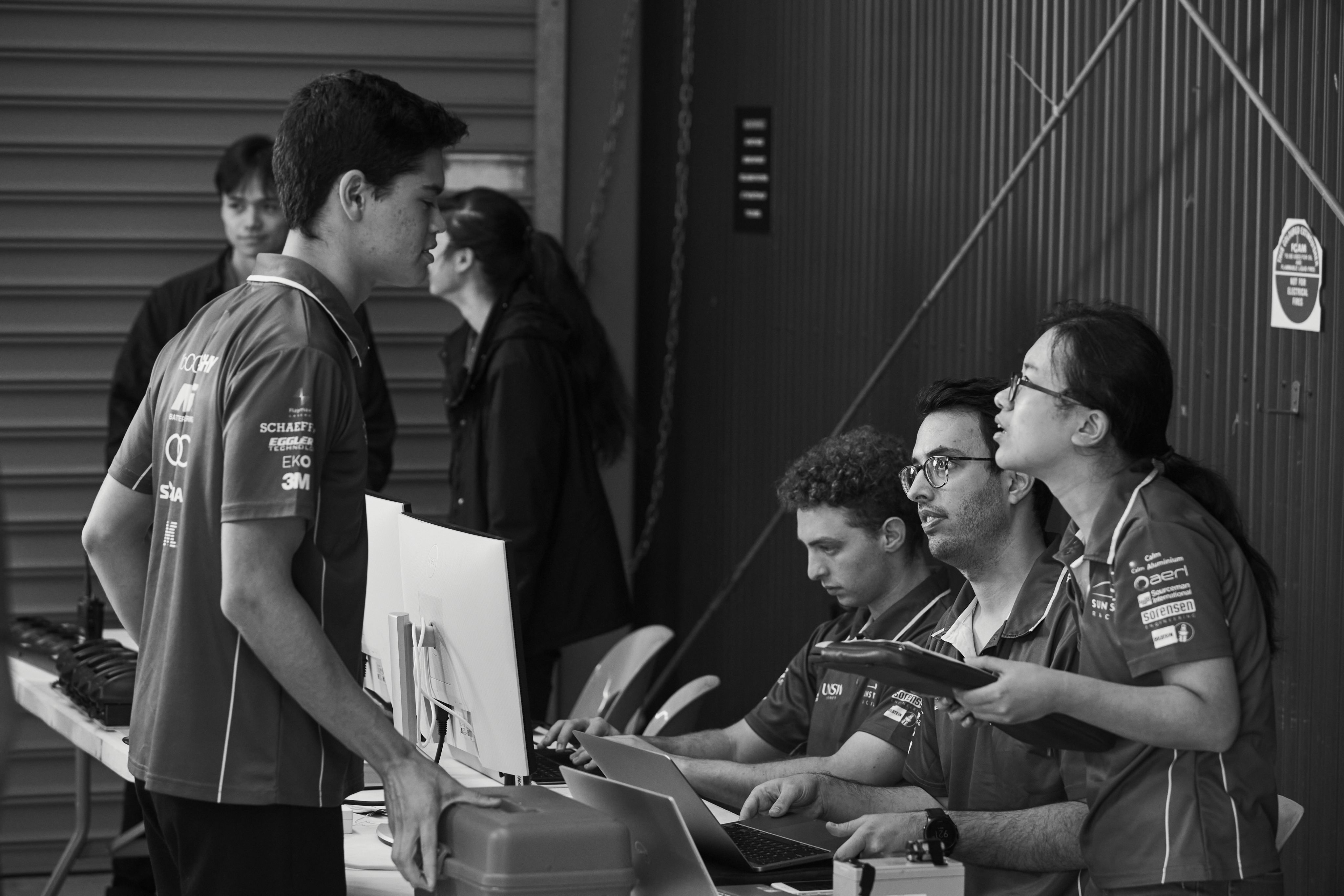
The result of the team’s effort is a car that weighs just 500kg, about one quarter that of a Tesla, and is so efficient that it will complete the 1000km world record attempt on just a single charge of its solar-powered battery.
That is the product of superb aerodynamics, with chief designer Ben Heina going back to the drawing board 57 times before he was happy with the car, as well as high performance in terms of converting energy from the solar cells to the battery, efficiency of the motors and throughout the drive chain, plus incredibly low rolling resistance.
All of which shows what is possible and what can be achieved, albeit with a significant weight advantage over road legal cars which require a host of safety features and also enjoy the benefits of an air conditioning system which Sunswift 7 has stripped out.
Due to the extensive use of carbon fibre, Sunswift 7 weighs in at just under 500kg. In comparison, a Tesla Model S tips the scales at around 2000kg.
To reduce weight, and therefore improve efficiency, Sunswift 7 does not feature any air conditioning, nor ABS brakes, nor airbags or even windscreen wipers.
'Drag coefficient' measures the way a vehicle passes through the surrounding air. The lower the coefficient, the more aerodynamic a car is. A Tesla Model S, for example, has a drag coefficient of 0.208. The drag coefficient of Sunswift 7 is just 0.095.
Sunswift 7 is designed to have very little rolling resistance, most notably thanks to work on its bearings, which means it needs much less power to keep it moving.
Sunswift 7 has a top speed of around 140km/h and can travel more than 1200km on a single charge of its battery.
But Prof. Hopkins says: “We are using a standard battery and a standard solar panel, but we have focused on making it a super-efficient car and shown what is possible.
“That efficiency means once we get up to 100km/h and take the foot off the accelerator I don’t think there is a straight stretch of road long enough, except for maybe somewhere in the Nullarbor, to measure how far it would keep going all on its own.
“Very little rolling resistance and very little air resistance are what makes this car so efficient. And when you have an efficient car, you don't need a lot of battery to make the whole car work.”
Time-laspse video of the Sunswift 7 build.
Time-laspse video of the Sunswift 7 build.
But how does that translate into a regular production car that the general public might be able to purchase in the next few years?
“The technology is largely there to do it,” adds Prof. Hopkins. “Obviously, there are some practical things that would change it from being instantly transferable overnight. This is a prototype vehicle. We don't even have windscreen wipers, let alone air conditioning, let alone ABS or airbags or other safety devices.
“Technology has made production cars more efficient over time, but other things have equalised that and all those safety features which add more weight are a necessary part. Nevertheless, even with those safety features removed, we are showing what is possible.
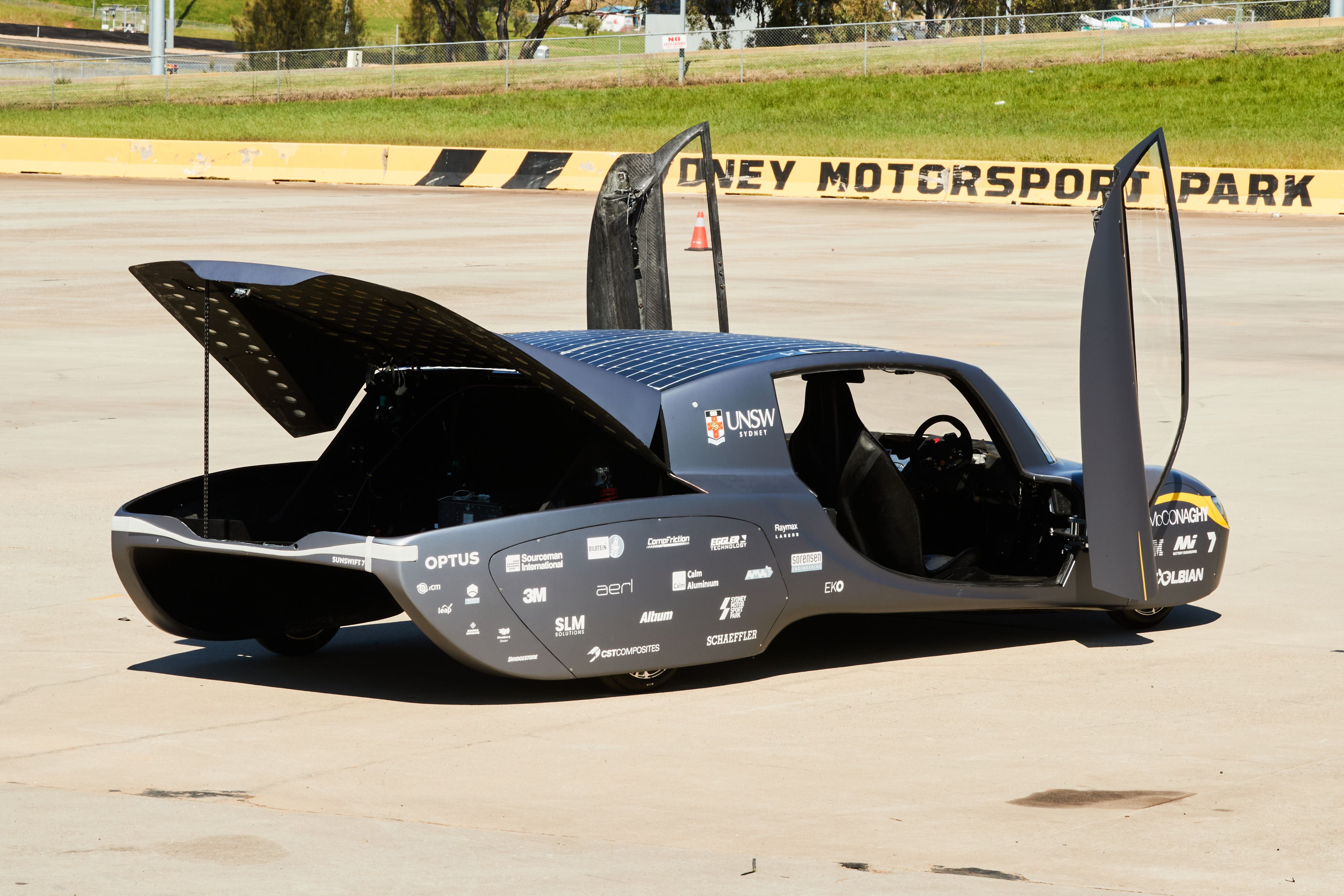
Sunswift 7 shows off its dihedral doors, inspired by those found on Koenigsegg luxury sports cars. Photo: UNSW Sydney / Richard Freeman
Sunswift 7 shows off its dihedral doors, inspired by those found on Koenigsegg luxury sports cars. Photo: UNSW Sydney / Richard Freeman
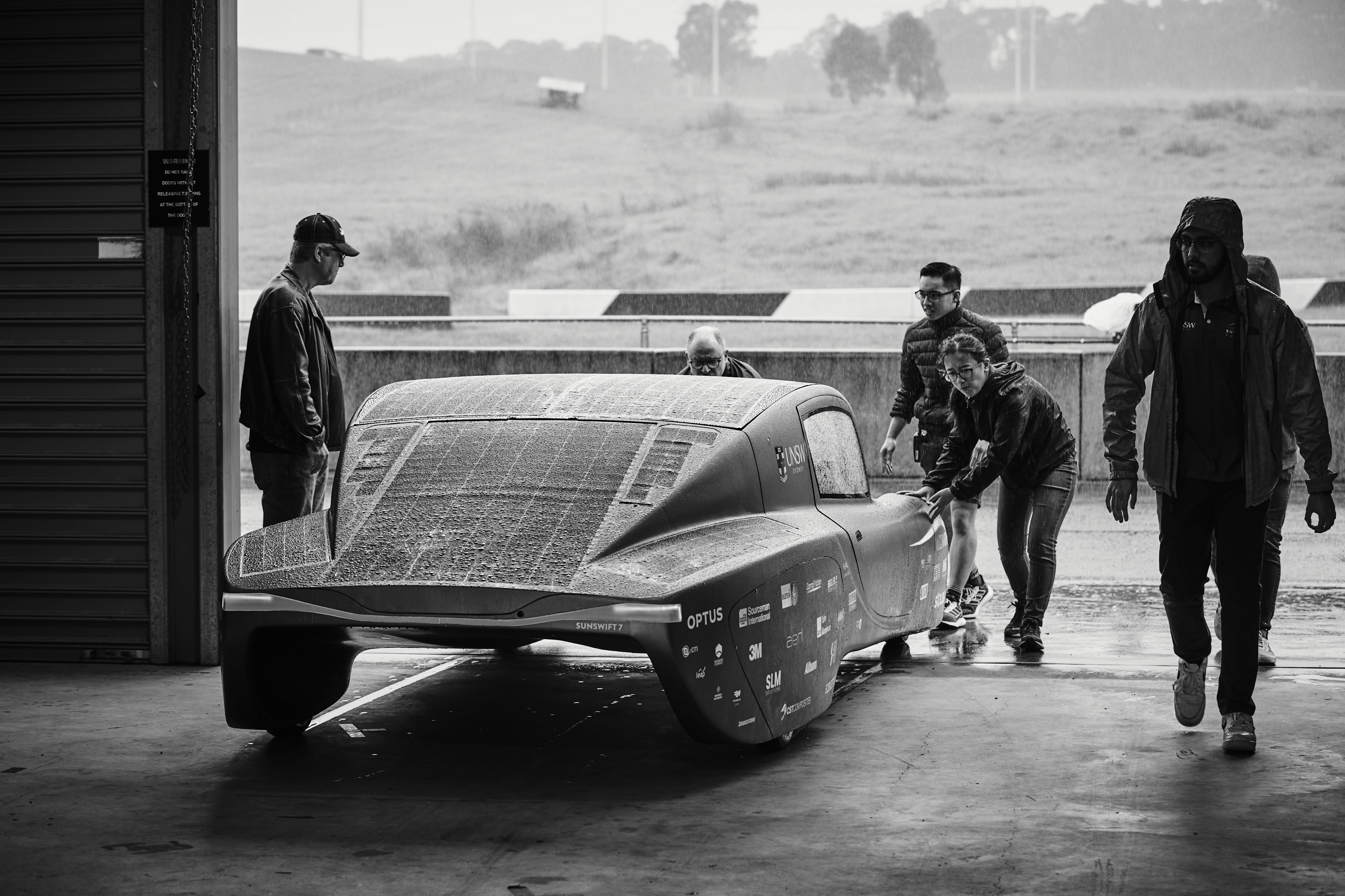
Sunswift 7 during a wet testing session at Sydney Motorsport Park. Photo: UNSW Sydney / Richard Freeman
Sunswift 7 during a wet testing session at Sydney Motorsport Park. Photo: UNSW Sydney / Richard Freeman
“Personally, I don’t think there is anything to say that in 20 years, even 10 years, we couldn’t have a regular production electric car that weighs 500kg with full safety features included that can travel 1000km on a single charge.
“With the Guinness World Record, if we can prove that we can drive a car at reasonably high speed and do 1000km, it proves the technology exists. We just need to do some polishing with that technology to make it mainstream.
“Yes, there are probably some things required to enable such cars of the future to be built that haven’t even been created yet. That’s the advancement of technology.
“What we are really doing with Sunswift is a feasibility study. It’s an exercise to show what is possible.
“It's there to agitate and disrupt. We can show what is potentially achievable, maybe not with the ingredients that are widely available to everyone right now – but definitely showing what’s possible.”
And even UNSW alumna Robyn Denholm, who succeeded Elon Musk as chair of Tesla in 2018, has seen first-hand what is possible after she visited the Sunswift team – and told the undergraduates what an amazing job she thought they were doing.
Sunswift:
An evolution
Sunswift 1
Purchased from the Aurora Vehicle Association in 1996. The car, Aurora Q1, was significantly upgraded and improved by the UNSW SRT and renamed Sunswift, under team leader Byron Kennedy.
It went on to race in the 1996 World Solar Challenge. The car was still a competitive entry despite its age, placing ninth out of 46 entries.
Weight: 255kg
Top Speed: 70km/h
Sunswift 2
Being the first scratch-built vehicle by the team, Sunswift (II) was a landmark vehicle marking the team’s intent to be properly involved in the solar racing vehicle scene.
Between 1997-2003, the team developed, refined and raced four versions of the car.
The team pioneered a cell encapsulation technique which allowed the moulding of solar panels to the curved aerodynamic shape of the car.
Weight: 180kg
Top Speed: 120km/h
Sunswift 3
The aim of UNSW Sunswift (III) was to design the world’s most efficient solar car while also pushing the boundaries of practicality at the time.
This car could also carry a passenger (facing backwards) behind the driver.
In 2007, Jaycar Sunswift (III) broke the world transcontinental record, completing the drive from Perth to Sydney in five-and-a-half days. The team then finished ninth overall, out of 41 international entrants, in the World Solar Challenge.
Weight: 220kg
Top Speed: 120km/h
Sunswift 4 (IVy)
IVy was built to compete in the 2009 World Solar Challenge, and was the first silicon powered car across the line, for fourth place overall. The project took 18 months and $250,000 to complete.
In the 2011 WSC, IVy was first in the Production Challenge Class and sixth overall. In January 2011, at HMAS Albatross, IVy broke the Guinness World Record for the fastest solar-powered vehicle (88.5km/h). The rules stated the car should be powered solely by the sun, so it weighed just 140kg for the record attempt as the battery was removed.
Weight: 165kg
Top Speed: 95km/h (with battery)
Sunswift 5 (eVe)
This car cost approximately $500,000 and was built to compete in the new Cruiser Class in the WSC.
This class focused on more practical solar cars with passenger seats added, greater safety features and more efficient batteries.
On a single charge of its batteries, eVe could travel up to 500km or over 800km if powered by its own solar cells.
In July 2014 Sunswift 5 broke the FIA World Record for the fastest electric vehicle capable of travelling 500km on a single battery charge, with an average speed of 107km/h over the distance.
The next year the car claimed third place in the WSC Cruiser class.
Weight: 430kg
Top Speed: 132km/h
Sunswift 6 (VIolet)
VIolet's design began in 2016, with manufacture being completed in late 2017. VIolet is Sunswift's first four-seat, four-door vehicle, boasting a 5-square-metre solar array consisting with an approximate efficiency of 22%, a massive contrast to Sunswift's earlier vehicles.
VIolet was designed with a greater focus on practicality, with the aim of resembling a more comfortable family vehicle in comparison to previous generations of Sunswift vehicles.
This car set a Guinness World Record for the lowest energy consumption while driving across Australia in an electric car, and then claimed second place overall and line honours in Cruiser Class in the Bridgestone World Solar Challenge.
Weight: 470kg
Top Speed: 140km/h
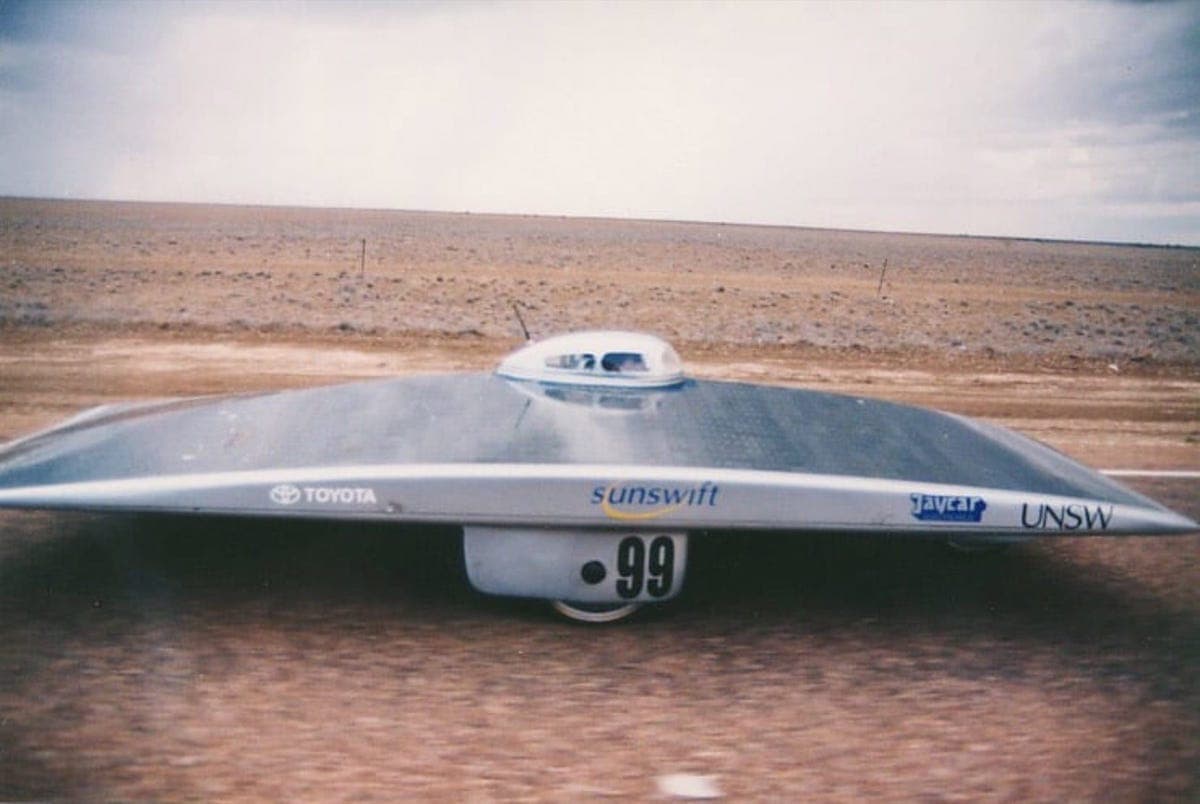
Sunswift 1
Sunswift 1
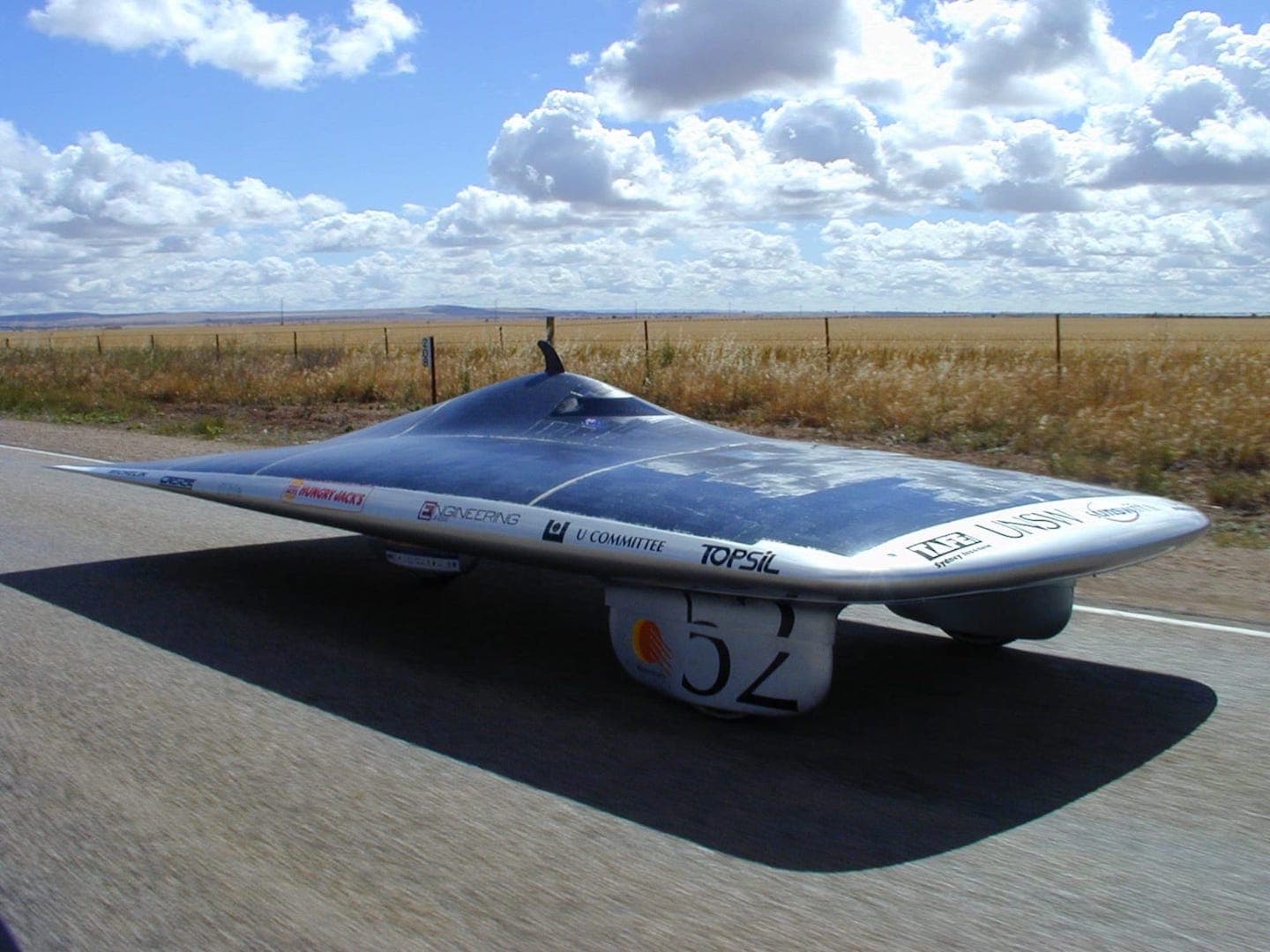
Sunswift 2
Sunswift 2
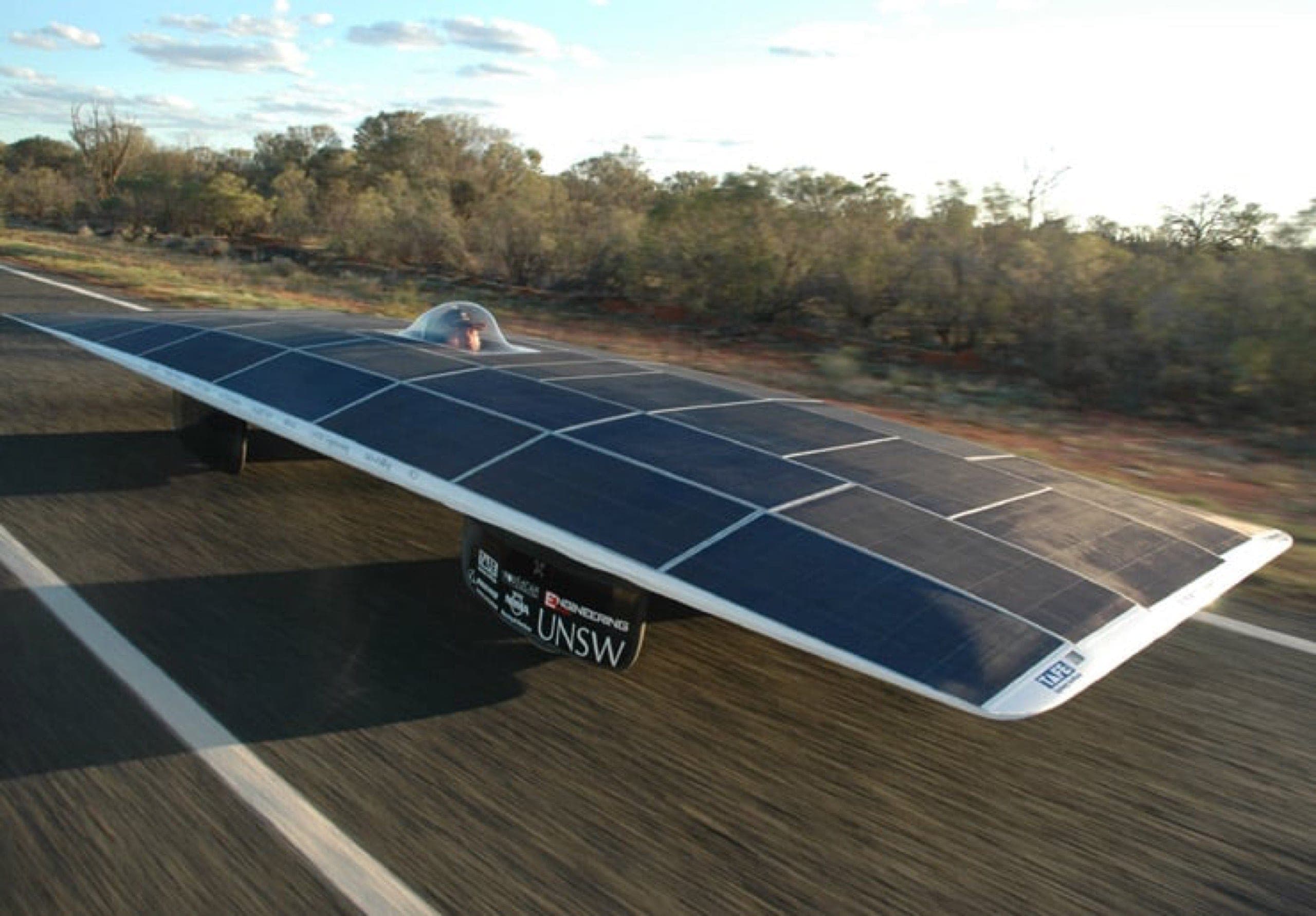
Sunswift 3
Sunswift 3
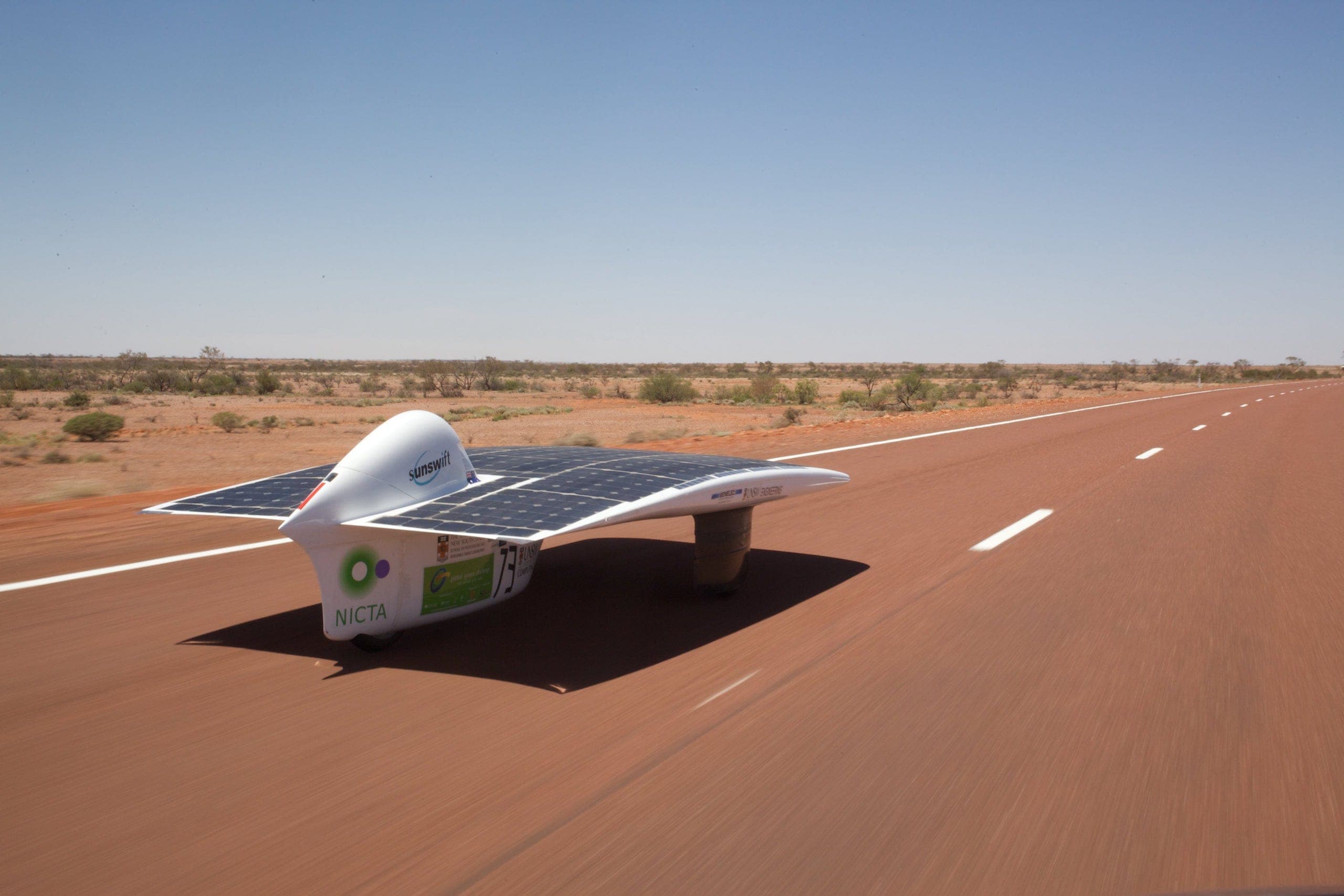
Sunswift 4
Sunswift 4
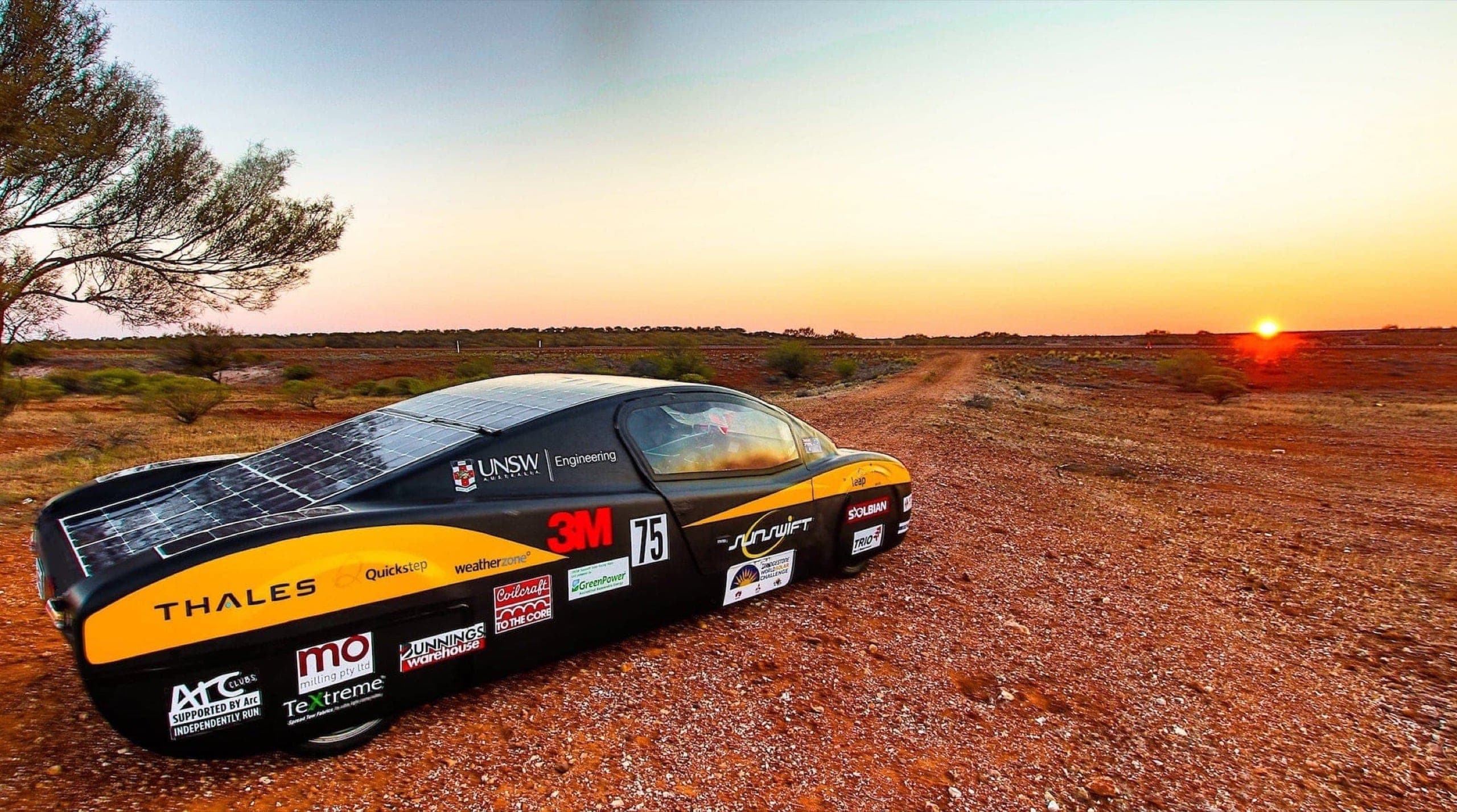
Sunswift 5
Sunswift 5
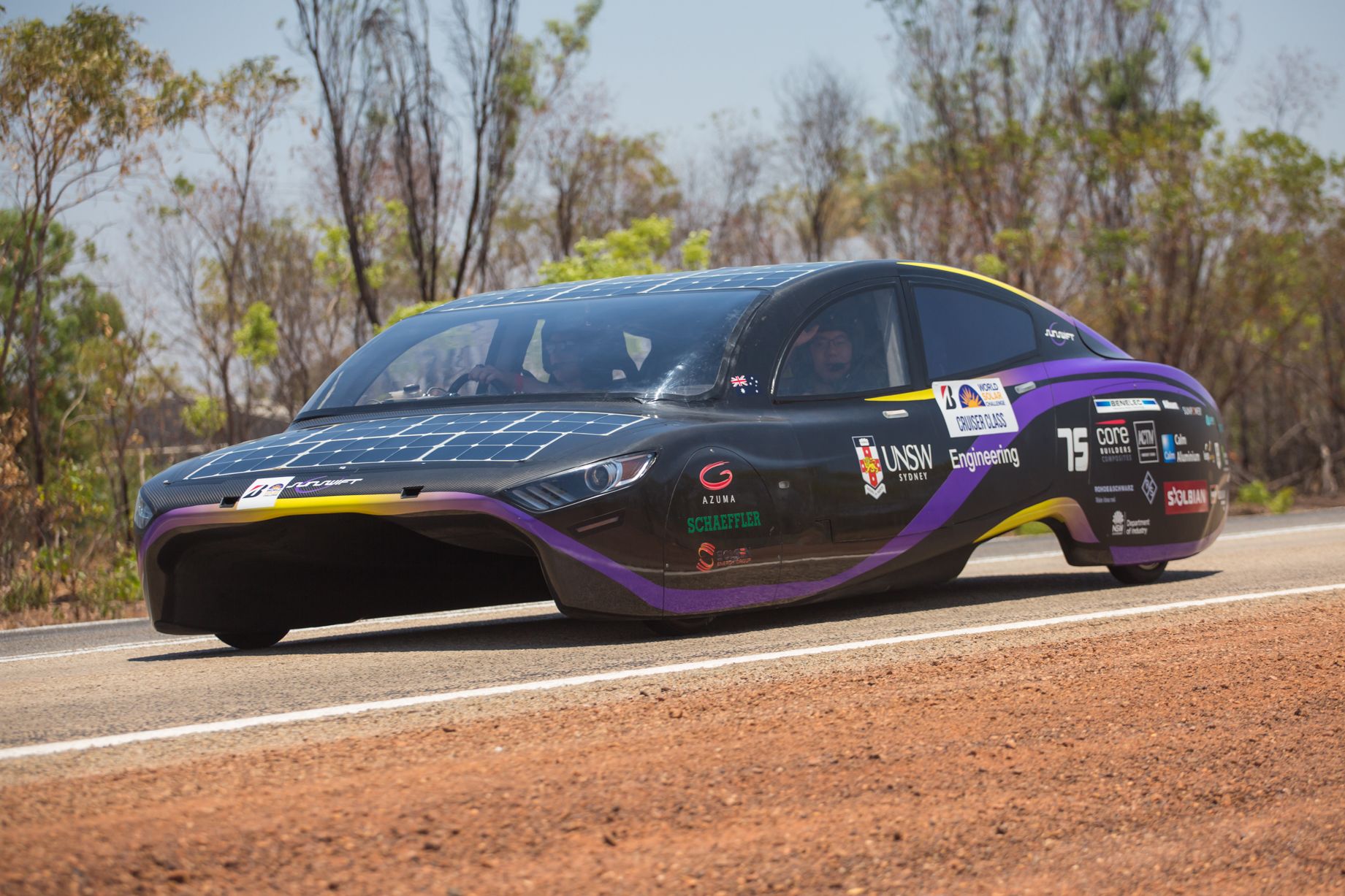
Sunswift 6
Sunswift 6
Sunswift 7:
The designer
Ben Heina was seven years old when he first started to draw and design cars – so it was a dream come true when he was handed the chance to craft Sunswift 7 into a potential world record breaker.
Even as a Mechanical Engineering undergraduate at UNSW he had no formal education in car design, so like most of the rest of the team he was forced to rapidly develop his skills.
“For the initial design I started with some sketches to just get a vision of what I thought would be good and then started to build that into computer-aided design (CAD) models," he says.
“From there, it was all about running aerodynamic simulations because aerodynamics dominates everything else on the car in terms of the effect it can have on power consumption.
“I went through 57 iterations of design before the final shape was determined, and in between that we had to make sure that everything else was going to work. So, how are we actually going to fit the solar cells on the car? How curved do they need to be? Can the solar cells withstand that curvature? Is there room for the suspension? Is there enough space for a driver?
“I had never really done aerodynamics before, just one subject on computational fluid dynamics (CFD), but that barely scratched the surface of what there is to know.
“In the end, my university thesis was on aerodynamics as well, because I enjoyed that element while working on the Sunswift car. The 57 iterations of design for that were basically by hand – each time I would run a simulation, analyse the results, adjust the CAD model, set it all up again and repeat the process like that over and over and over again.
“It’s really time-consuming and I thought there had to be a better way. So I went and did some research for my thesis and managed to automate a lot of the process to the point where a program now runs the simulation and then can change the geometry of the car on its own, to reduce drag.
“It then re-runs the simulation, changes geometry again if needed and cycles through that loop until it achieves a target that you have set.
“Overall, designing Sunswift 7 has been a dream come true. I wanted to build a car that when people see it for the first time they think: ‘Oh, I’d really like to drive that and have it in my garage’. Rather than it just looking like a strange futuristic space car.
“But we also have a record attempt which will validate whether the whole Sunswift team have achieved our goal, which is to say we’ve built the best solar car in the world.
“I think that will also show to the public what is possible with electric cars. At the moment, they still have these concerns about range, about going on long road trips, about charging the battery all the time.
“Sunswift 7 shows that an electric car can have the range, can have the power, can have the charging capacity, everything's right there.”
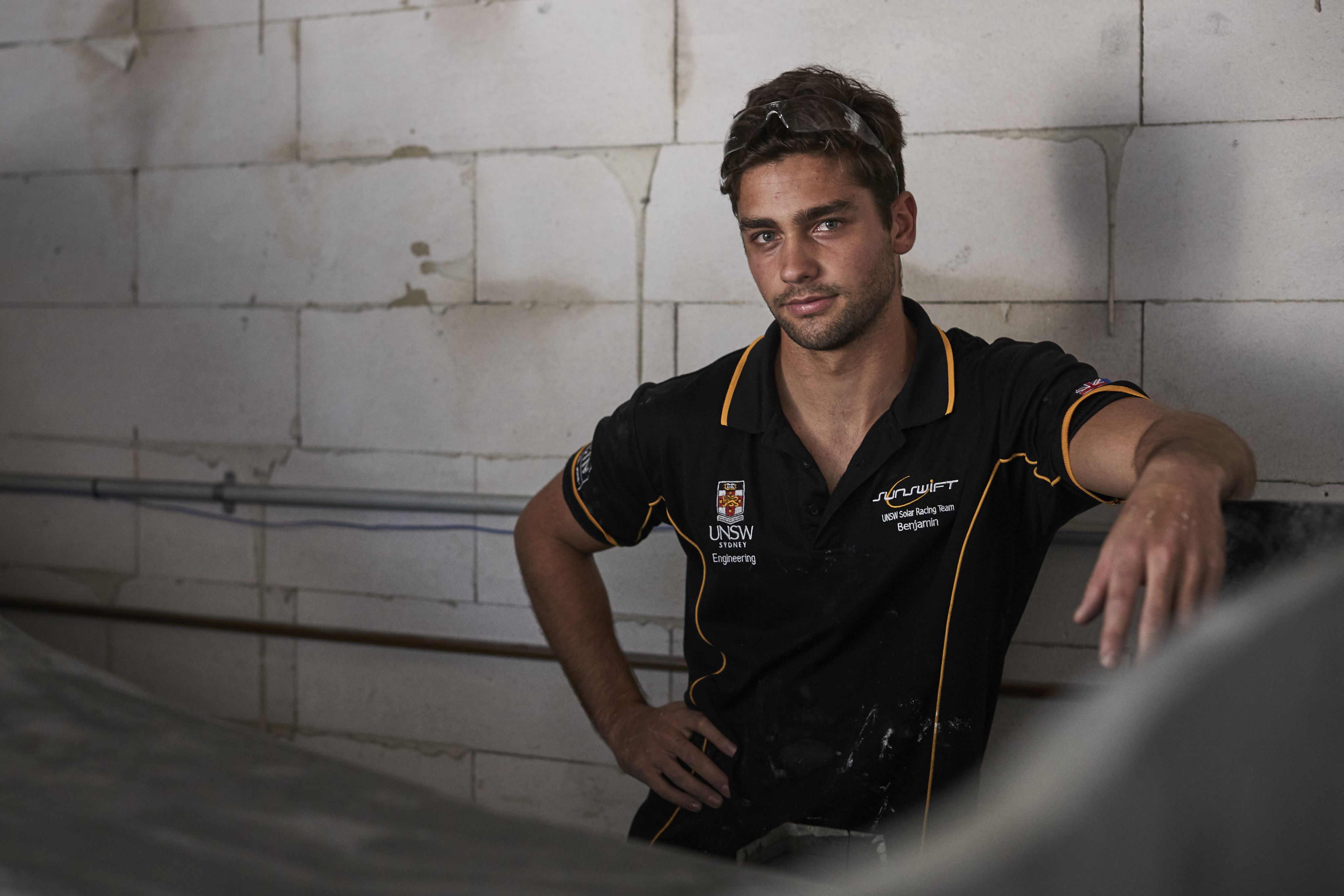

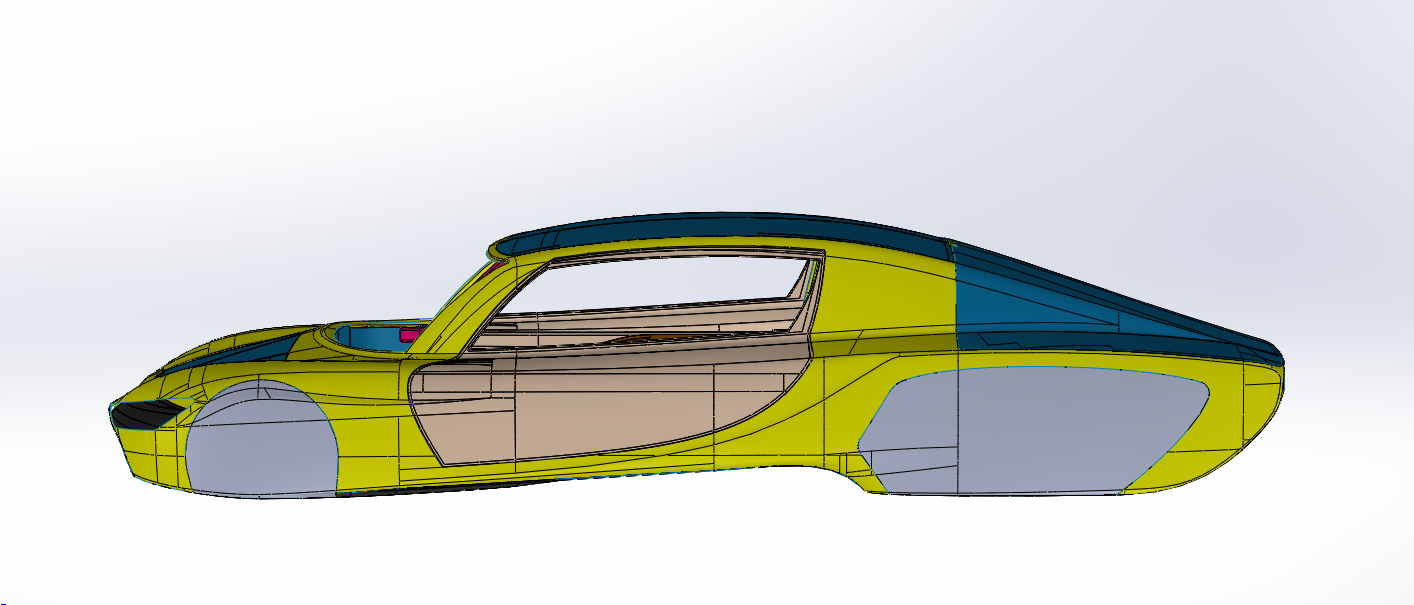
Original CAD design of
Sunswift 7 by Ben Heina.
Final build of Sunswift 7
on the track.
As well as the Guinness World Record attempt, Sunswift 7 will push the boundaries of what is technically possible with regards to remote driving.
In association with team technical partner Optus, the vehicle will have 5G receivers and cameras installed, allowing it to be driven by someone outside the car wearing a virtual headset.
And that someone will be none other than 2021 Bathurst 1000 winner Chaz Mostert who will pilot Sunswift around the famous Mount Panorama track in October.
Full speed ahead:
Sunswift Institute
With the benefit of more than 25 years of solar car development, the next big plan is for UNSW to launch the Sunswift Institute which will bring racing, technological innovation and automotive development all under one umbrella.
Prof. Hopkins believes that will continue to push the boundaries of what is possible for consumer electric vehicles of the future.
“The Sunswift Institute will stand for the advancement of technology in transport and ensure that we are innovators in that space. We want to be prepared to take risks because if we are attempting things that are safe, that’s boring.
“I think now is the time to really go out there and try to shift the needle, be ahead of the curve and do things that people haven’t done. It’s one thing to improve on what’s already been done, but let’s see if there are also completely different ways of doing things," he says.
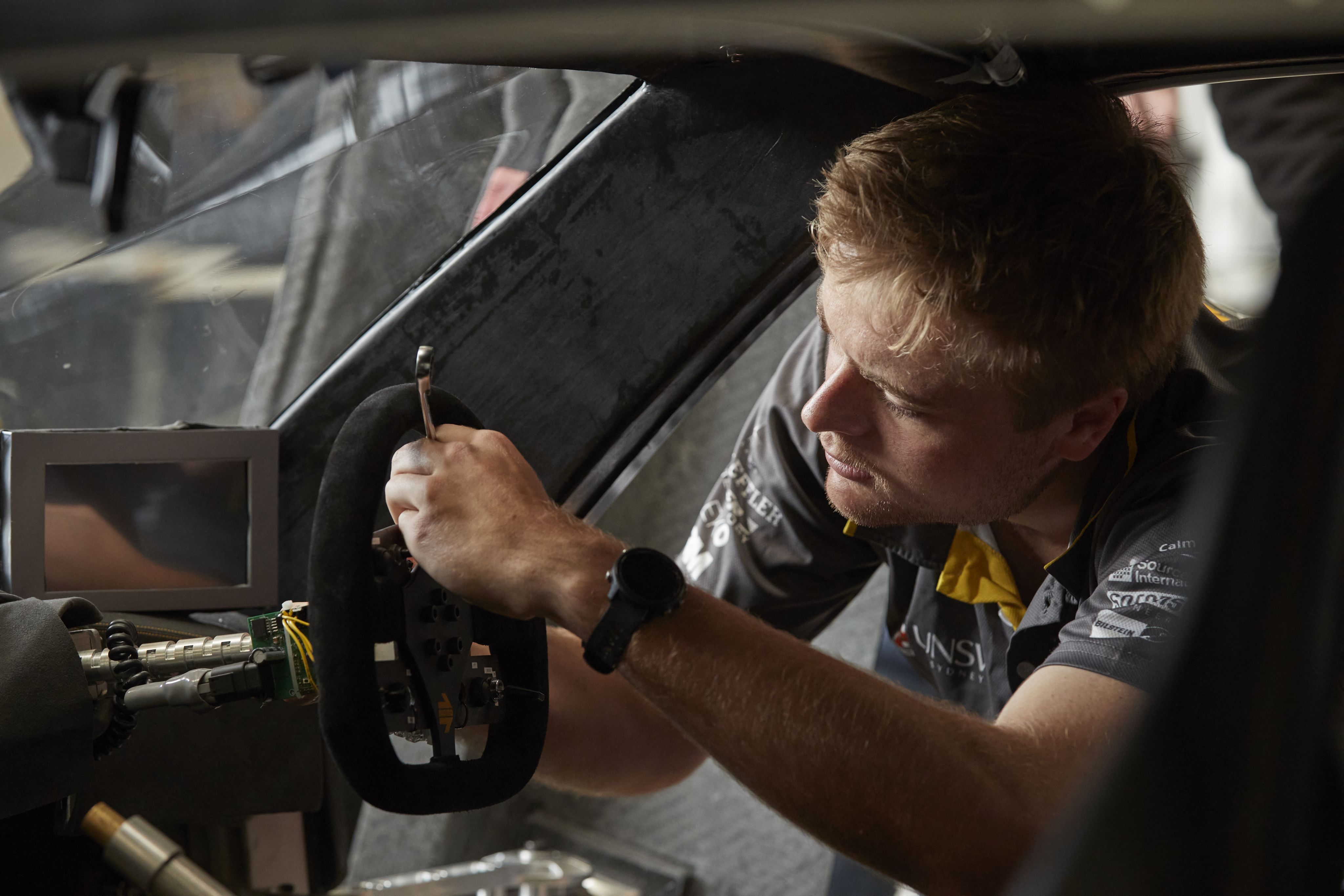
Sunswift team member makes adjustments to the car during a track testing session. Photo: UNSW Sydney / Richard Freeman
Sunswift team member makes adjustments to the car during a track testing session. Photo: UNSW Sydney / Richard Freeman
“We want to be known as innovators, but also to help build something here in Australia. We don’t want to teach great students just to have them get on a plane to work for prestigious companies in other countries.
“And I absolutely believe that motorsport and innovation work together to provide benefits to mainstream car buyers. You only have to look at Mercedes and the hybrid technology they have in their road cars which is a direct transition from their Formula One team.”
CREDITS
Story: Neil Martin
Photos: Richard Freeman, Ben Heina, Sunswift Racing
Video: Lee Henderson, Marty Jamieson, Aleks Wynne, Richard Freeman, Jake Willis
Multimedia production: Neil Martin, Belinda Henwood, Peter Harrison, Lee Henderson, Cecilia Duong
Social media: Oliver Watt, Cecilia Duong